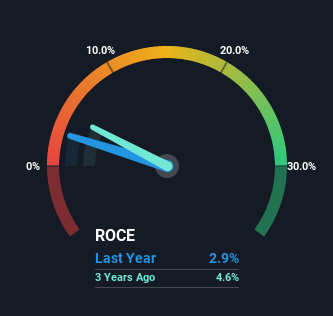- Canada
- /
- Renewable Energy
- /
- TSX:BEPC
Some Investors May Be Worried About Brookfield Renewable's (TSE:BEPC) Returns On Capital

If we want to find a potential multi-bagger, often there are underlying trends that can provide clues. In a perfect world, we'd like to see a company investing more capital into its business and ideally the returns earned from that capital are also increasing. Ultimately, this demonstrates that it's a business that is reinvesting profits at increasing rates of return. However, after briefly looking over the numbers, we don't think Brookfield Renewable (TSE:BEPC) has the makings of a multi-bagger going forward, but let's have a look at why that may be.
Understanding Return On Capital Employed (ROCE)
Just to clarify if you're unsure, ROCE is a metric for evaluating how much pre-tax income (in percentage terms) a company earns on the capital invested in its business. The formula for this calculation on Brookfield Renewable is:
Return on Capital Employed = Earnings Before Interest and Tax (EBIT) ÷ (Total Assets - Current Liabilities)
0.029 = US$952m ÷ (US$42b - US$9.0b) (Based on the trailing twelve months to December 2021).
So, Brookfield Renewable has an ROCE of 2.9%. Ultimately, that's a low return and it under-performs the Renewable Energy industry average of 3.8%.
View our latest analysis for Brookfield Renewable

Above you can see how the current ROCE for Brookfield Renewable compares to its prior returns on capital, but there's only so much you can tell from the past. If you're interested, you can view the analysts predictions in our free report on analyst forecasts for the company.
So How Is Brookfield Renewable's ROCE Trending?
When we looked at the ROCE trend at Brookfield Renewable, we didn't gain much confidence. Around four years ago the returns on capital were 7.3%, but since then they've fallen to 2.9%. Meanwhile, the business is utilizing more capital but this hasn't moved the needle much in terms of sales in the past 12 months, so this could reflect longer term investments. It may take some time before the company starts to see any change in earnings from these investments.
On a side note, Brookfield Renewable's current liabilities have increased over the last four years to 21% of total assets, effectively distorting the ROCE to some degree. If current liabilities hadn't increased as much as they did, the ROCE could actually be even lower. Keep an eye on this ratio, because the business could encounter some new risks if this metric gets too high.
The Bottom Line On Brookfield Renewable's ROCE
Bringing it all together, while we're somewhat encouraged by Brookfield Renewable's reinvestment in its own business, we're aware that returns are shrinking. Unsurprisingly then, the total return to shareholders over the last year has been flat. In any case, the stock doesn't have these traits of a multi-bagger discussed above, so if that's what you're looking for, we think you'd have more luck elsewhere.
One more thing: We've identified 4 warning signs with Brookfield Renewable (at least 2 which are potentially serious) , and understanding these would certainly be useful.
While Brookfield Renewable isn't earning the highest return, check out this free list of companies that are earning high returns on equity with solid balance sheets.
Valuation is complex, but we're here to simplify it.
Discover if Brookfield Renewable might be undervalued or overvalued with our detailed analysis, featuring fair value estimates, potential risks, dividends, insider trades, and its financial condition.
Access Free AnalysisHave feedback on this article? Concerned about the content? Get in touch with us directly. Alternatively, email editorial-team (at) simplywallst.com.
This article by Simply Wall St is general in nature. We provide commentary based on historical data and analyst forecasts only using an unbiased methodology and our articles are not intended to be financial advice. It does not constitute a recommendation to buy or sell any stock, and does not take account of your objectives, or your financial situation. We aim to bring you long-term focused analysis driven by fundamental data. Note that our analysis may not factor in the latest price-sensitive company announcements or qualitative material. Simply Wall St has no position in any stocks mentioned.
About TSX:BEPC
Brookfield Renewable
Owns and operates a portfolio of renewable power and sustainable solution assets.
Good value slight.
Market Insights
Community Narratives




